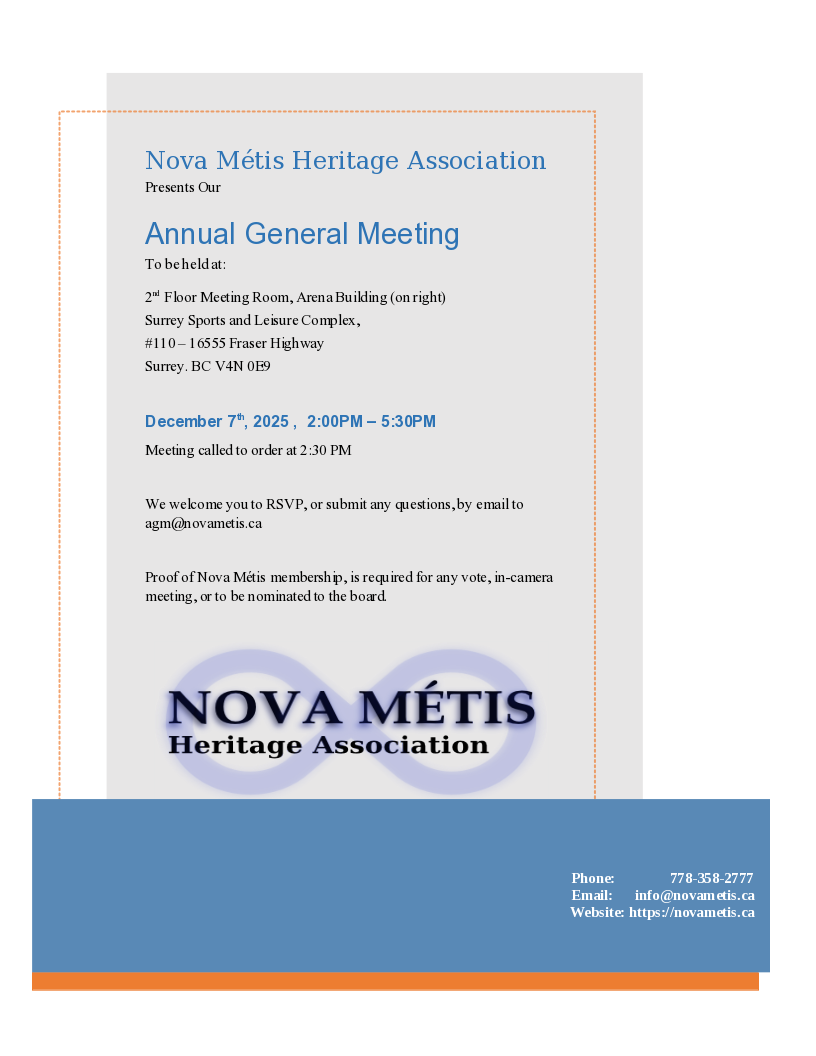 Nova Métis Heritage Association will be hosting our 2025 Annual General Meeting (AGM),
Nova Métis Heritage Association will be hosting our 2025 Annual General Meeting (AGM),
on Sunday, December 7th, 2025, from 2pm to 5:30pm with a 2:30pm Call to Order.
The meeting will take place at the Surrey Sports and Leisure Complex, Areana Building - 2nd Floor Multi-Purpose Room,
Address: #100 - 16555 Fraser Highway Surrey, BC V4N 0E9
Beverages, Free Lunch ;), and Door Prizes
Any members, associate members, and their families are welcome to attend. Only Nova Métis Heritage Association members in good standing may participate in any vote or in-camera meeting or nomination to the Board (membership is by proof of card or certificate).
We do welcome you to RSVP, or submit any questions, by email to This email address is being protected from spambots. You need JavaScript enabled to view it.
AGM Package PDF including Agenda (click to download/view)
Financial Report 2024 Dec (locked PDF)
Financial Report 2025 October (locked PDF)
 The Sash is a finger woven belt made of wool approximately three meters long. Traditionally it was tied at the waist to hold a coat closed. The sash was used for both decorative and practical purposes. It could be used as a rope, the fringes could be used as thread to repair items, a first aid kit, and a wash-cloth just to name a few. Today it is a symbol of nationhood and cultural distinction and it is still an important part of traditional Métis dress.
The Sash is a finger woven belt made of wool approximately three meters long. Traditionally it was tied at the waist to hold a coat closed. The sash was used for both decorative and practical purposes. It could be used as a rope, the fringes could be used as thread to repair items, a first aid kit, and a wash-cloth just to name a few. Today it is a symbol of nationhood and cultural distinction and it is still an important part of traditional Métis dress.
Both European and First Nations cultures influenced Métis art; however, Métis art also had an influence on First Nations groups. Métis art often was mislabeled and credit was given to other groups, even when the Métis were the first to bead. The Métis were famous for their floral beadwork, and were often called the ‘Flower Beadwork People’. The symmetrical floral beadwork was often set against a dark background, was inspired by European floral designs. The needle workers used materials from both cultures: quills, beads, and silk embroidery thread. The Métis used geometric patterns, and floral motifs to create unique and distinct style.
The Métis (pronounced “May-tee”) are one of the recognized distinct Aboriginal Peoples in Canada. During the height of the fur trade in the 18th and 19th centuries, many European fur traders married First Nations women. The eventual establishment of Métis communities outside of these cultures and settlements, as well as the intermarriage between Métis men and Métis women, resulted in a new Aboriginal people—the Métis. The Métis people helped to shape the Canada of today, mainly in terms of the expansion of the West.
The Métis are a distinct Aboriginal nation and share a history, culture (song, dance, dress, national symbols, etc.), a unique language (Michif), distinct way of life, and a collective identity. The Métis homeland includes regions scattered across Canada, as well as parts of the northern United States.